technical data AUDI S8 2009 Owner's Manual
[x] Cancel search | Manufacturer: AUDI, Model Year: 2009, Model line: S8, Model: AUDI S8 2009Pages: 408, PDF Size: 91.63 MB
Page 229 of 408
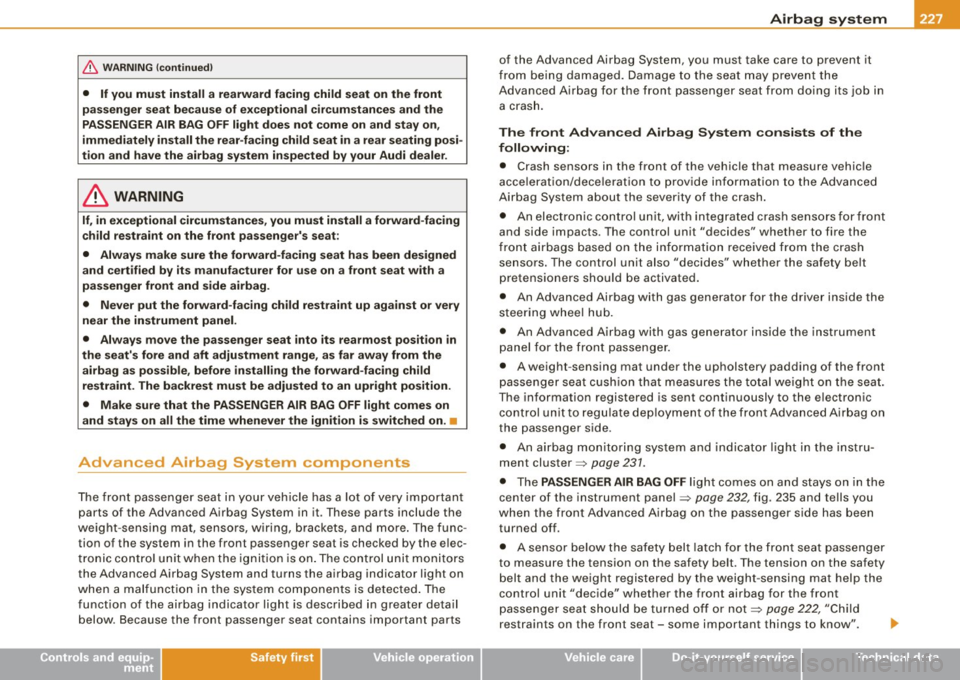
__________________________________________________ A_ i_ r _b _a...; g::- s_ y=--- s_t _e _m __ lll
& W ARNING (continued )
• If you must in stall a rearward facing child seat on the front
passenger seat because of exceptional circumstances and the
PASSENGER AIR BAG OFF light does not come on and stay on,
immediately install the rear -facing child seat in a rear seating posi
tion and have the airbag system inspected by your Audi deale r.
& WARNING
If, in exceptional circumstances , you must install a forward -facing
child restraint on the front passenger' s seat :
• Always make sure the forward -facing seat has been designed
and certified by its manufacturer for use on a front seat with a
passenger front and side airbag .
• Never put the forward -facing child restraint up against or very
near the instrument panel.
• Always move the passenger seat into its rearmost position in
the seat's fore and aft adjustment range , as far away from the
airbag as possible , before installing the forward -facing child
restraint. The backrest must be adjusted to an upright position.
• Make sure that the PASSENGER AIR BAG OFF light comes on
and stays on all the time whenever the ignition is switched on . •
Advanced Airbag System components
T he front passenger seat in your vehicle has a lot of very i mporta nt
parts of the Advanced A irbag System in it . T hese parts inc lude the
we ig ht -sens ing mat, se nso rs, w iring, bra cke ts, and more . The func
tion of the system in the front passenger seat is checked by the e lec
tr onic con trol uni t w hen the ig nit io n i s on. T he co ntro l u nit mo nitors
the Advanced Airbag System and turns the a irbag indicator li ght on
w he n a mal fu ncti on in th e sy ste m com ponen ts is de tec ted . Th e
function of the airba g indicator lig ht is desc ribed in greater detail
below . Because the front passenge r seat contains important parts
Controls and equip ment Safety first Vehicle operation of the Advanced Airbag System, you must
take care to prevent it
fro m being damaged. Damage to the sea t may prevent t he
Advanced Airbag for the front passenger seat from doing its job in
a cra sh.
The front Advanced Airbag System consists of the
following: • C rash sensors in the front of the vehicle that measure vehic le
acce lera tion/dece lera tio n to p rovide i nfo rm ati on to the A dva nce d
Airbag System about the severity of the crash .
• An ele ctro nic c ontrol unit , with integ ra te d crash se nsors f or front
and side impacts. The control unit "decides" whether to fire the
fr ont airbags based on the info rmati on receive d from the cras h
sensors. The control unit also "decides" whethe r th e safety belt
p retens ione rs sh ould be activated .
• An Advanced Airbag with gas generator for the driv er inside th e
stee ring w hee l hub .
• A n Advanced Airbag with gas gene rator inside the instrument
p a nel for the fr ont pa ssen ger.
• A weight -sens ing mat under the upholstery padding of the front
pa ssenge r sea t cush io n th a t m eas ures the tot al w eig ht on the se at .
T he info rmation registered is sent continuously to the e lect ron ic
c on tro l unit t o reg ulate de plo ym en t of th e fr ont A dva nce d Ai rbag on
th e passenger sid e.
• An airbag monito rin g syst em and indicator lig ht in the instru
ment cluster => page
231 .
• The PASSENGER AIR BAG OFF lig ht co mes o n an d stays on in th e
center of the instrument panel=> page
232 , fig. 235 and tells you
w hen th e front A dv anced Air b ag o n the p asseng er s ide h as been
turned off .
• A se nso r be low t he safety belt l atc h for the fro nt sea t pass enger
to measure the tension on the safety be lt . T he tension on the safety
belt and the w eigh t re giste red by the wei ght-s en sing mat h elp t he
control unit "decide" whether the front airbag for the front
p asse nge r seat shou ld be t urned off or not => pag e
222, "Child
restraints on the front seat -some important things to know". _,.
Vehicle care Do-it-yourself service Technical data
Page 233 of 408
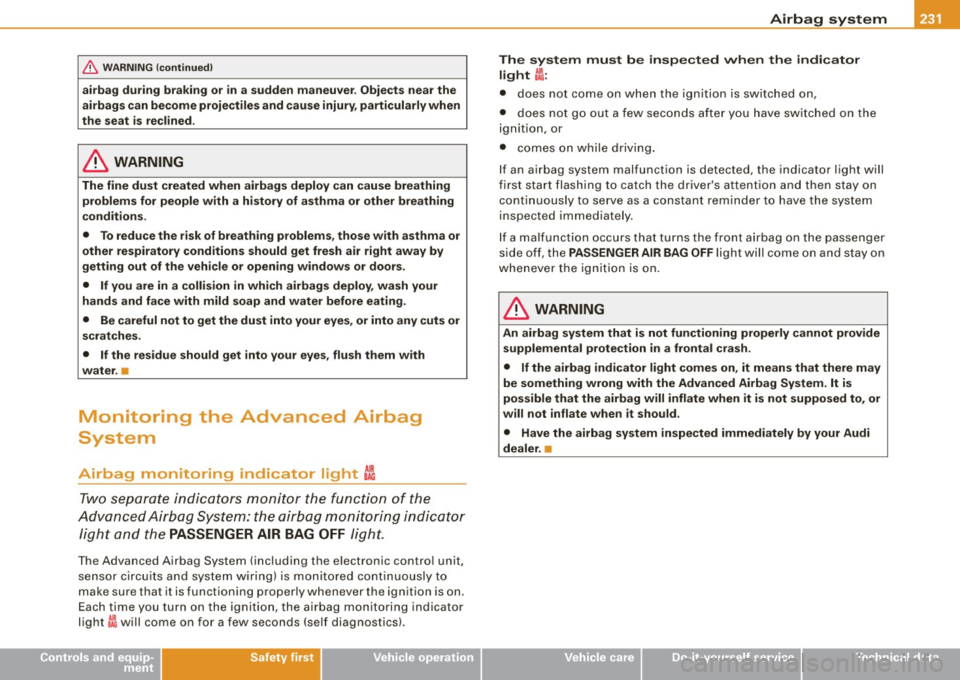
Airbag system -----------------=~-
& WARNING (continued )
airbag dur ing braking or in a sudden maneuver . Objects ne ar the
airbags can become proje ctile s and cau se injury , particularly when
the seat is reclined .
& WARNING
The fine dust created when airbags deploy can cause breathing
p roblems for people with a history of asthma or other breathing
c onditions .
• To reduce the risk of breathing problems , those with asthma or
other respir atory cond itions should get fresh air right away by
getting out of the vehicle or opening windows or doors.
• If you are in a collision in which airbags deploy, wash your
hands and face with mild soap and water before eating.
• Be careful not to get the dust into your eyes, or into any cuts or
scratches.
• If the residue should get into your eyes , flush them with
water .•
Monitoring the Advanced Airbag
System
Airbag monitoring indicator light t~
Tw o separate indicators monitor th e funct ion of the
Adva nced A irbag Syst em : the a ir b ag mon itor in g i ndicator
l ig ht an d the
PASSENGER AIR BAG OFF light.
The Advanced Airbag System (including the electronic control unit,
s en sor cir cu its a nd sys tem wiring) is mon itored co ntinuous ly to
make sure that it is functioning properly whenever the ignition is on.
E ac h tim e you turn on th e ig niti on, the ai rbag monito ring ind icator
light
t~ w ill come on for a few seconds (se lf diagnostics) .
Controls and equip ment Safety first Vehicle operation
The system must be inspected wh
en the indicator
light ~:
• does not come on when the ignition is switched on,
• does not go ou t a few sec ond s a fter you have swi tc hed on the
ignition, or
• comes on while d riv in g.
I f an airbag system malfunction is detected, the indicator light will
fi rst sta rt fla sh ing to catch the d rive r's atten tion an d t hen stay on
cont inuously to serve as a constant reminder to have the syst em
inspected i mmedia tely.
If a mal funct ion occurs that tu rns the fro nt a irbag o n th e passe nger
side off, the PASSENGER AIR BAG OFF light will come on and stay on
whe neve r the ig nit ion is on.
& WARNING
An airbag system that is not functioning properly cannot provide
supplemental protection in a frontal crash .
• If the airbag indicator light comes on , it means that there may
be something wrong with the Advanced Airbag System. It is
possible that the airbag will inflate when it is not supposed to , or
will not inflate when it should .
• Have the airbag system inspected immediately by your Audi
dealer .•
Vehicle care Do-it-yourself service Technical data
Page 235 of 408
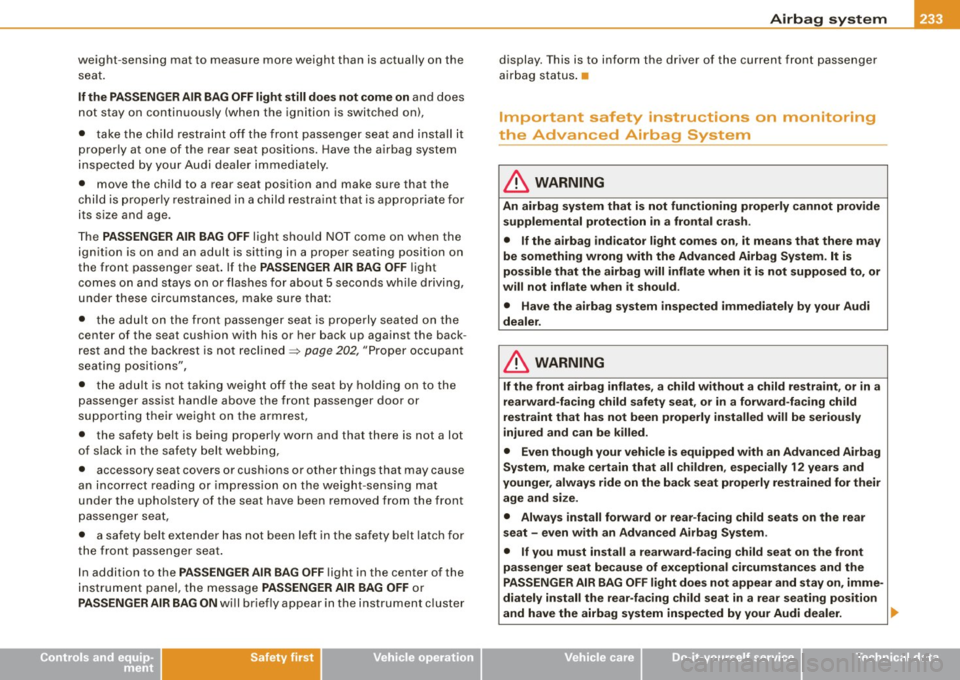
Airbag syst em -----------------=~-
weight -sensing mat to measure more weight than is actually on the
seat .
If th e PA SSENGER AIR BAG OFF light still d oes not come on and does
not stay on continuously (when the ignition is switched on),
• t ake the child r estraint off the front passenger seat and install it
properly at one of the rear seat positions. Have the airbag system
inspected by your Audi dealer immediately.
• move the child to a rear seat position and make sure that the
child is proper ly restrained in a child restraint that is appropria te for
its size and age .
The
PA SSENGER AIR BAG OFF light shou ld NOT come on when the
ignition is on and an adult is sitting in a proper seating posi tion on
the front passenger seat . If the
PASSENGER AIR BAG OFF light
comes on and stays on or flashes for about 5 seconds whi le driving,
under these circumstances, make sure that :
• the adu lt on the front passenger sea t is properly seated on the
center of the seat cushion w ith his or her back up against the back
res t and the backrest is not reclined => page 202, "Proper occupant
sea ting positions" ,
• the adult is not taking weight of f the sea t by holding on to the
passenger assist handle above the front passenger door or
supporting their we ight on the armrest,
• the safety belt is being proper ly worn and that there is not a lot
of slack in the safety belt webbing,
• accessory seat covers or cushions or other things that may cause
an incorrect reading or impression on the weight -sensing mat
under the upho lstery of the seat have been removed from the front
passenger sea t,
• a safety belt extender has not been left in the safety be lt latch for
t he front passenger seat .
In addition to the
PASSENGER AIR BAG OFF light in the center of the
instrument pane l, the message
PASSENGER AIR BAG O FF o r
PAS SEN GER AIR BA G ON will briefly appear in the instrument c luster
Controls and equip
ment Safety first Vehicle operation
display. This is to inform the driver of the current front passenger
a
irbag status .•
Important safety instructions on monitoring
the Advanced Airbag System
& WARNING
An airbag sy stem that is not functioning properly cannot provide
supplemental protection in a front al cra sh .
• If the airbag ind icator li ght come s on , it means that there may
be something wrong with the Advanced Airbag S ystem . It is
po ssible that the airbag will inflate when it is not suppo sed to , or
w ill not infl ate when it should .
• Have the airb ag system inspe cted immediatel y by you r Audi
dealer.
& WARNING
If the front airba g inflates , a child with out a child re straint , or in a
re arw ard -fa cing chi ld safety seat , or
in a forward-fa cing child
r e str aint that has not been properly installed will be seriously
inj ured and can be killed .
• Even though your vehicle i s equipped with an Adv anced Airbag
Sy stem , m ake cert ain that all children , e speci ally 12 year s and
younger , always ride on the bac k seat prope rly re strain ed for their
a ge and siz e .
• Alway s install forw ard or rear -facing child seat s on the rear
se at - ev en with an Ad vanced Airbag Sy stem .
• If you mu st install a rearward -fa cing child se at o n th e front
p ass enger sea t be cau se of e xceptional circumstan ce s and the
PASSENGER AIR BAG OFF light doe s not appear and stay on , imme
diately in stall the rear -fac ing child seat in a r ear sea ting pos itio n
and have the airbag system inspect ed b y your Audi dealer . .,,
Vehicle care Do-it-yourself service Technical data
Page 237 of 408
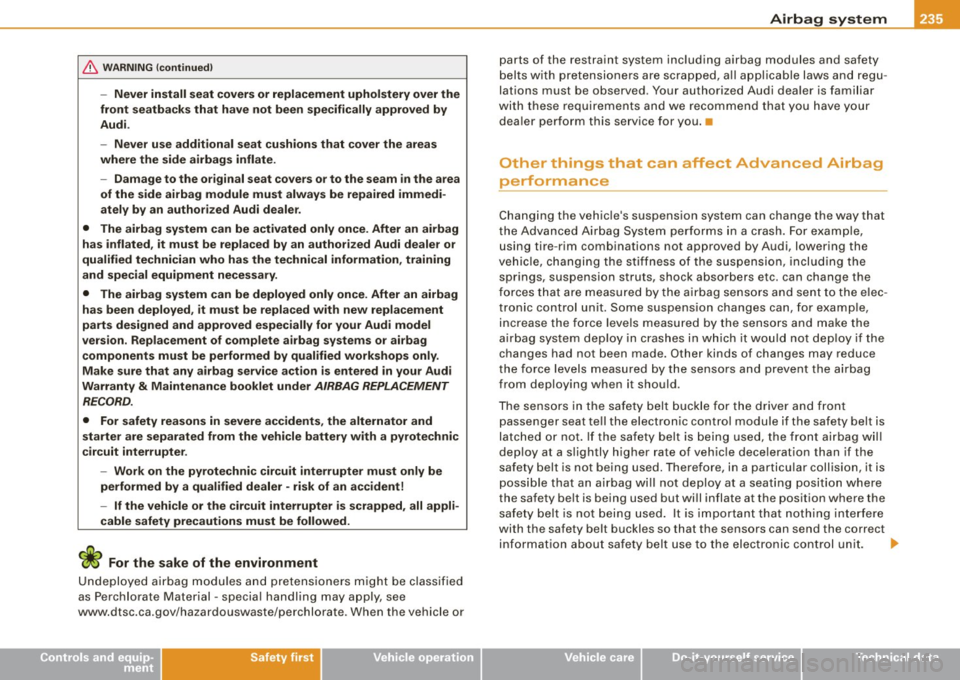
Airbag system -----------------=~-
& WARNING (continued )
-Never install seat covers or replacement upholstery over the
front seatbacks that ha ve not been specifically approved by
Audi .
- Never use additional seat cush ions that cover the areas
where the side airbags inflate.
- Damage to the or iginal seat covers or to the seam in the area
of the s ide airbag module must always be repaired immedi
ately by an authorized Audi dealer .
• The airbag system can be activated only once. After an airbag
has inflated , it must be replaced by an authorized Audi dealer or
qualified technician who has the technical information , training
and special equipment nece ssary .
• The airbag system can be deployed only once . After an airbag
has been deployed , it must be replaced with new replacement
parts designed and approved especially for your Audi model
version . Replacement of complete airbag systems or airbag
components must be performed by qualified workshops only .
Make sure that any airbag service action is entered in you r Audi
Warranty
& Maintenance booklet under AIRBAG REPLACEMENT
RECORD .
• For safety reasons in severe accidents , the alternator and
starter are separated from the vehicle battery with a pyrotechnic
c ircuit interrupter .
- Work on the pyrotechnic circuit interrupter must only be
performed by a qualified dealer -risk of an accident!
- If the vehi cle or the circuit interrupter is scrapped , all appli
cable safety precautions must be followed .
For the sake of the environment
Undepl oyed airbag m odu les a nd preten sioners m ig ht b e class if ied
as Perchlorate Material -specia l handling may apply, see
www .dtsc.ca.gov/hazardouswaste/perchlorate. When the vehicle or
Controls and equip
ment Safety first Vehicle operation
parts of the restraint system inc
luding a irbag modules and safety
be lts with p re tensione rs are sc rapped, a ll a ppl icable laws an d regu
lations must be observed . Your authorized Audi dea ler is fami liar
wi th the se requi rements and we recomme nd that you have y our
dea ler perform this service for you. •
Other things that can affect Advanced Airbag
performance
Changing the veh ic le 's suspens ion s ystem can change th e way that
t he Adva nced Air bag Sys tem perfo rm s in a crash. F or e xam ple,
using tire -r im combinations not approv ed by Audi, lower ing the
ve hic le, c hangi ng th e st iffne ss of the su spen sion , inclu ding the
springs, suspension struts, shock absorbers e tc . can change the
forc es that are measu re d b y th e a irbag sens ors and sent to the elec
t ron ic control u nit. Some sus pensio n chan ges can , for examp le ,
inc rea se the f orce le v els mea sured by the senso rs and make the
a irb ag sys te m de plo y in cras hes in whi ch it wo uld not de p loy i f the
changes had not been made . Other kinds of changes may reduce
t he force le v e ls measured by t he se nso rs a nd preve nt t he a irba g
from deploying when it should .
T he se nsor s in th e safe ty bel t buckl e f or th e d river a nd front
passen ger seat te ll the e lectronic control module if the safety belt is
l a tc h e d or n ot. If t he safety belt i s being use d, th e fr ont ai rbag w ill
dep loy at a s lightly h ig her rate of v eh ic le dec elerat ion t han if the
safet y belt is not being used . Ther efore, in a partic ular collision, it is
poss ible that an airba g w ill not deplo y at a seati ng pos itio n wh ere
the safety be lt is be ing used but wi ll inflate at the position where the
sa fe ty be lt is no t being used . It i s im porta nt that n othi ng i nterfe re
with the safety belt b uckles so that the sensors can send the correct
i n fo rm ati on about sa fety belt use t o th e el ectronic con trol unit. _..
Vehicle care Do-it-yourself service Technical data
Page 243 of 408
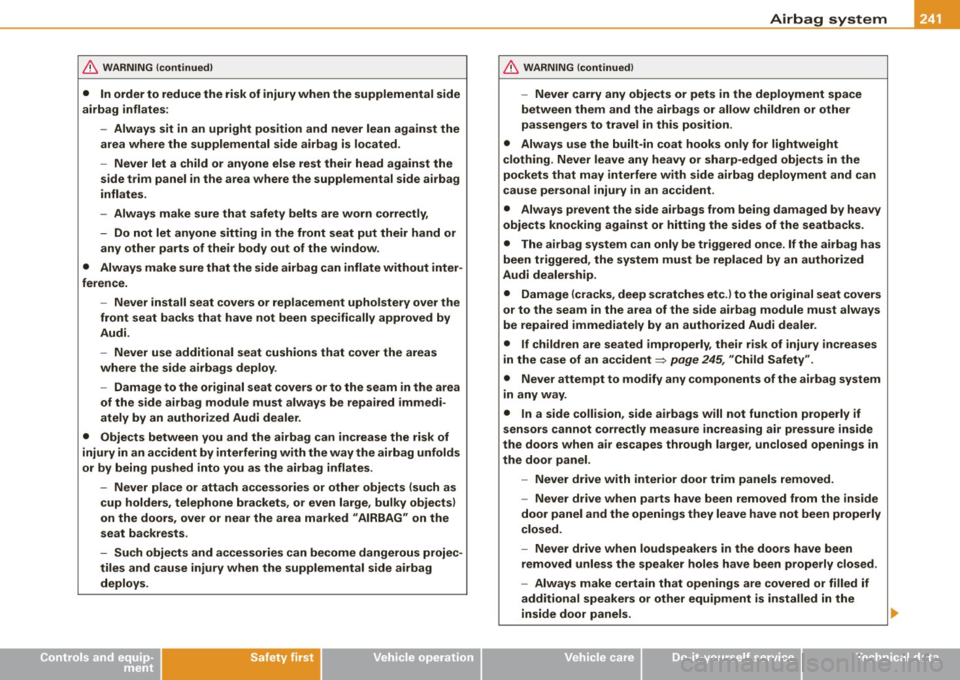
_______________________________________________ .=_A ::_ i :.:.r ~b ~a:=.; 9!:!...: S~ y[: s~ t~ e:::_ m ~ ----
& WARNING (continued)
• In order to reduce the risk of injury when the supplemental side
airbag inflates:
-Always sit in an upright position and never lean against the
area where the supplemental side airbag is located .
- Never let a child or anyone else rest their head against the
side trim panel in the area where the supplemental side airbag
inflates.
- Always make sure that safety belts are worn correctly,
- Do not let anyone sitting in the front seat put their hand or any other parts of their body out of the window.
• Always make sure that the side airbag can inflate without inter
ference.
-Never install seat covers or replacement upholstery over the
front seat backs that have not been specifically approved by
Audi.
- Never use additional seat cushions that cover the areas
where the side airbags deploy .
- Damage to the original seat covers or to the seam in the area
of the side airbag module must always be repaired immedi
ately by an authorized Audi dealer .
• Objects between you and the airbag can increase the risk of
injury in an accident by interfering with the way the airbag unfolds
or by being pushed into you as the airbag inflates .
- Never place or attach accessories or other objects (such as
cup holders, telephone brackets, or even large, bulky objects)
on the doors, over or near the area marked "AIRBAG" on the
seat backrests .
- Such objects and accessories can become dangerous projec
tiles and cause injury when the supplemental side airbag deploys.
Controls and equip ment Safety first
Vehicle operation
& WARNING (continued)
-Never carry any objects or pets in the deployment space
between them and the airbags or allow children or other
passengers to travel in this position .
• Always use the built -in coat hooks only for lightweight
clothing. Never leave any heavy or sharp-edged objects in the
pockets that may interfere with side airbag deployment and can
cause personal injury in an accident .
• Always prevent the side airbags from being damaged by heavy
objects knocking against or hitting the sides of the seatbacks.
• The airbag system can only be triggered once. If the airbag has
been triggered, the system must be replaced by an authorized
Audi dealership.
• Damage (cracks, deep scratches etc.I to the original seat covers
or to the seam in the area of the side airbag module must always
be repaired immediately by an authorized Audi dealer.
• If children are seated improperly, their risk of injury increases
in the case of an accident=>
page 245, "Child Safety".
• Never attempt to modify any components of the airbag system
in any way.
• In a side collision, side airbags will not function properly if
sensors cannot correctly measure increasing air pressure inside
the doors when air escapes through larger, unclosed openings in
the door panel.
-Never drive with interior door trim panels removed.
- Never drive when parts have been removed from the inside
door panel and the openings they leave have not been properly
closed.
- Never drive when loudspeakers in the doors have been
removed unless the speaker holes have been properly closed .
- Always make certain that openings are covered or filled if
additional speakers or other equipment is installed in the
inside door panels.
Vehicle care Do-it-yourself service Technical data
Page 247 of 408
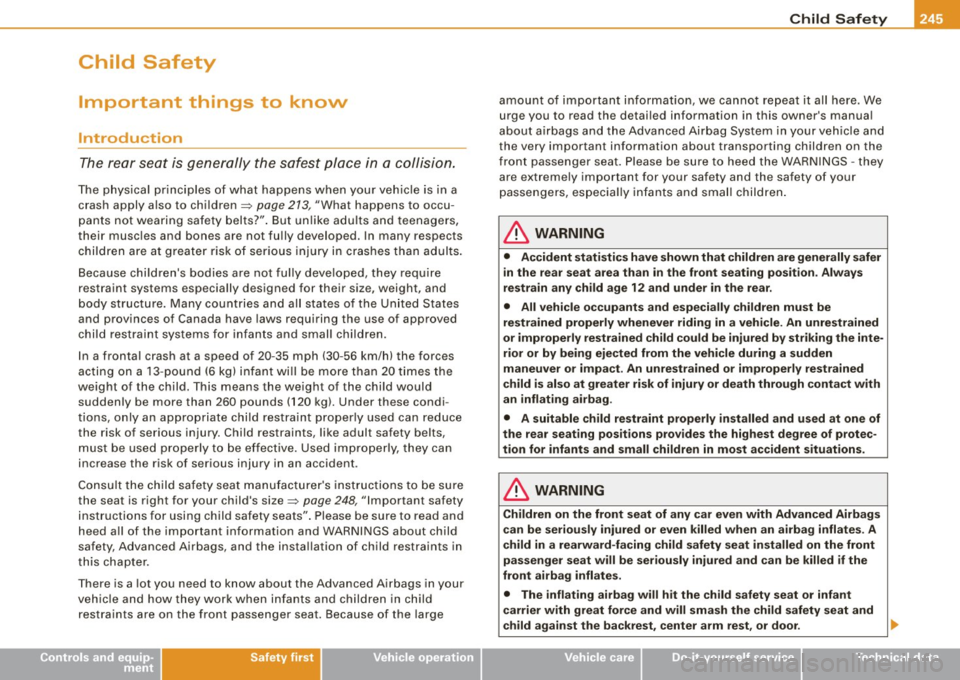
_______________________________________________ C_h _ i_ld _ S_ a_ f_ e_ t..,:c y __ lftlll
Child Safety
Important things to know
Introduction
The rear seat is generally the safes t place in a collision.
The p hysica l pr inciples of what happens when you r veh ic le is in a
crash apply also to children=>
page 213, "What happens to occu
pa nts not wearing safety bel ts?" . But un like adults and teenagers,
their musc les and bones are not fully developed. In many respects
children a re a t greater ris k of serious injury in cras hes than a dults .
B ecause chi ldren's bodies are no t fully deve loped, they require
restraint systems especial ly designed for their size, weight, and
body structu re. Ma ny countries and al l sta tes of the U nited States
and provinces of Canada have laws requiring the use of approved
chil d restraint sys te m s for infa nts and smal l children .
I n a frontal crash at a speed of 20 -35 mph (30 -56 km/h) the forces
acting on a 13-pou nd (6 kg) infant wi ll be mo re than 20 times the
weight of the child. This means the weight of the child would
suddenly be more than 260 pounds ( 120 kg). Under these condi
t ions, only an appropriate child restraint proper ly used can reduce
the risk of serious injury. Child restraints, like adult safety belts,
must be used properly t o be effective. Used impro perly, they can
increase the risk of serious injury in an accident.
Co nsul t the c hild safety seat man ufacture r's ins truc tions to be su re
the seat is right for your child's size=>
page 248, "Important safety
instructions for using child safety seats" . Please be sure to read and
heed a ll of the important information and WARNI NGS about child
safety, Advanced Airbags, and the insta llation of child restraints in
this chapter.
T here is a lot you need to know about the Advanced Airbags in your
veh ic le and how they work whe n inf an ts and ch ild ren in c hild
restraints are on the front passenger seat. Because of the large
Controls and equip ment Safety first Vehicle operation amoun
t of important informat ion, we cannot repeat it all here. We
urge you to read the detai led information in this owner's manua l
about a irbags and the Advanced Airbag Sys tem in your ve hic le and
the very important information about transporting children on the
fr ont passenger sea t. Please b e sure to hee d th e WAR NINGS -th ey
are extreme ly important for your safety and the safety of your
p asse ngers, es pecia lly inf ant s and s mall ch ildren .
& WARNING
• Accident statistics have shown that children are generally safer
in the rear seat area than in the front seating position . Always
restrain any child age 12 and under in the rear.
• All vehicle o ccupants and especially children must be
restrained properly whenever riding in a vehicle . An unrestrained
or improperly restrained child could be injured by striking the inte
rior or by being ejected from the vehicle during a sudden
maneuver o r impact . An unrestrained or improperly restrained
c hild is also at greater risk of injury or death through conta ct with
an inflating a irbag .
• A suitable child restraint properly installed and used at one of
the rear seating positions provides the highest degree of protec
tion for infants and small children in most ac cident situations .
& WARNING
Children on the front seat of any car even with Advanced Airb ag s
c an be seriously injured or even killed when an airbag inflates . A
child in a rearward -fa cing child safety seat installed on the front
pas senger seat will be seriously injured and can be killed if the
front airbag inflates.
• The inflating airbag will hit the ch ild safety seat or infant
carrier with great force and will sma sh the child safety seat and
child against the backrest , center arm rest , or door. •
Vehicle care Do-it-yourself service Technical data
Page 249 of 408
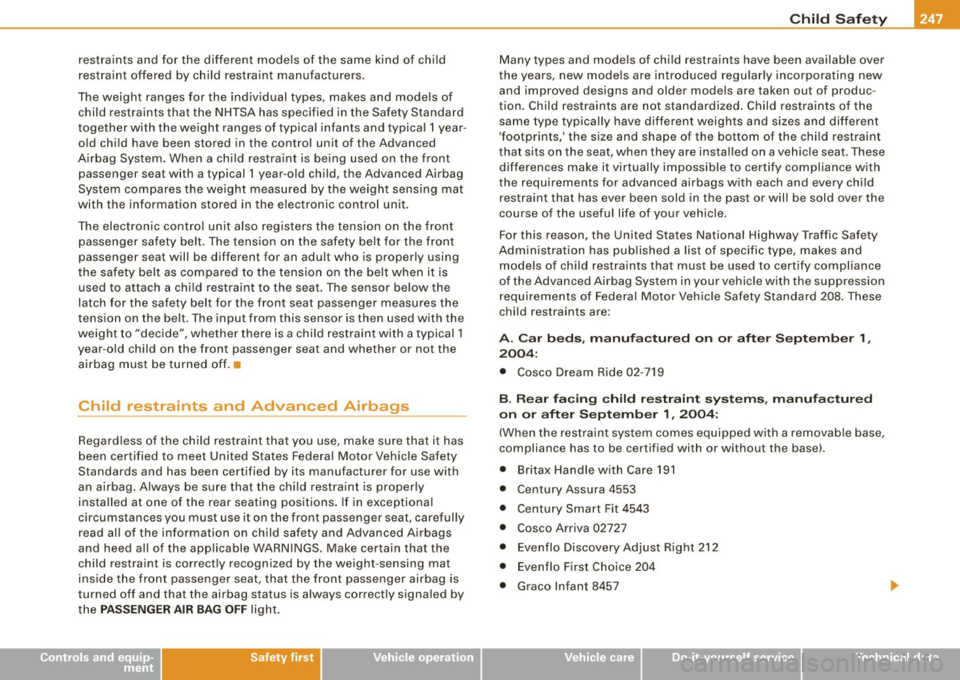
-----------------------------------------~C::_! h~ i~ ld ~ S~a !_!f ~e _!;tY L _ffllll
restraints and for the different models of the same kind of child
restraint offered by child restraint manufacturers.
The weight ranges for the individual types, makes and models of
child restraints that the NHTSA has specified in the Safety Standard
together with the weight ranges of typ ical infants and typical 1 year
old child have been stored in the control unit of the Advanced
Airbag System. When a child restraint is being used on the front
passenger seat with a typical 1 year -old child, the Advanced Airbag
System compares the weight measured by the weight sensing mat
with the information stored in the electronic control unit.
The electronic control unit also registers the tension on the front
passenger safety belt. The tension on the safety belt for the front
passenger seat will be different for an adult who is properly using
the safety belt as compared to the tension on the belt when it is
used to attach a child restraint to the seat. The sensor below the
latch for the safety belt for the front seat passenger measures the
tension on the belt . The input from this sensor is then used with the
weight to "decide" , whether there is a child restraint with a typical 1
year-old child on the front passenger seat and whether or not the airbag must be turned off.•
Child restraints and Advanced Airbags
Regardless of the child restraint that you use, make sure that it has
been certified to meet United States Federal Motor Vehicle Safety
Standards and has been certified by its manufacturer for use with
an airbag. Always be sure that the chi ld restraint is properly
installed at one of the rear seating positions. If in exceptiona l
circumstances you must use it on the front passenger seat, carefully
read all of the information on child safety and Advanced Airbags
and heed a ll of the applicable WARNINGS. Make certain that the
child restraint is correctly recognized by the weight -sensing mat
inside the front passenger seat, that the front passenger airbag is
turned off and that the airbag status is always correctly signaled by
th e
PASSENGER AIR BAG OFF light .
Controls and equip
ment Safety first Vehicle operation
Many
types and models of child restraints have been available over
the years, new mode ls are introduced regularly incorporating new
and improved designs and older mode ls are taken out of produc
tion. Child restraints are not standardized . Child restraints of the
same type typically have different weights and sizes and different
'footprints,' the size and shape of the bottom of the chi ld restraint
that sits on the seat, when they are installed on a vehicle sea t. These
differences make it virtual ly impossible to certify comp liance with
the requirements for advanced airbags with each and every child
restraint that has ever been sold in the past or will be sold over the
course of the usefu l life of your vehic le.
For this reason, the United States National Highway Traffic Safety
Administration has pub lished a list of specific type, makes and
models of child restraints that must be used to certify compliance
of the Advanced Airbag System in your vehicle with the suppression
requirements of Federal Motor Vehicle Safety Standard 208. These
child restraints are:
A. Car beds, manufactured on or after September 1,
2004:
• Cosco Dream Ride 02-719
B. Rear facing child restraint systems, manufactured
on or after September 1, 2004:
(When the restraint system comes equipped with a removable base,
compliance has to be certified with or without the base) .
• Britax Handle with Care 191
• Century Assura 4553
• Century Smart Fit 4543
• Cosco Arriva 02727
• Evenflo Discovery Adjust Right 212
• Evenflo First Choice 204
• Graco lnfant8457
Vehicle care Do-it-yourself service Technical data
Page 251 of 408
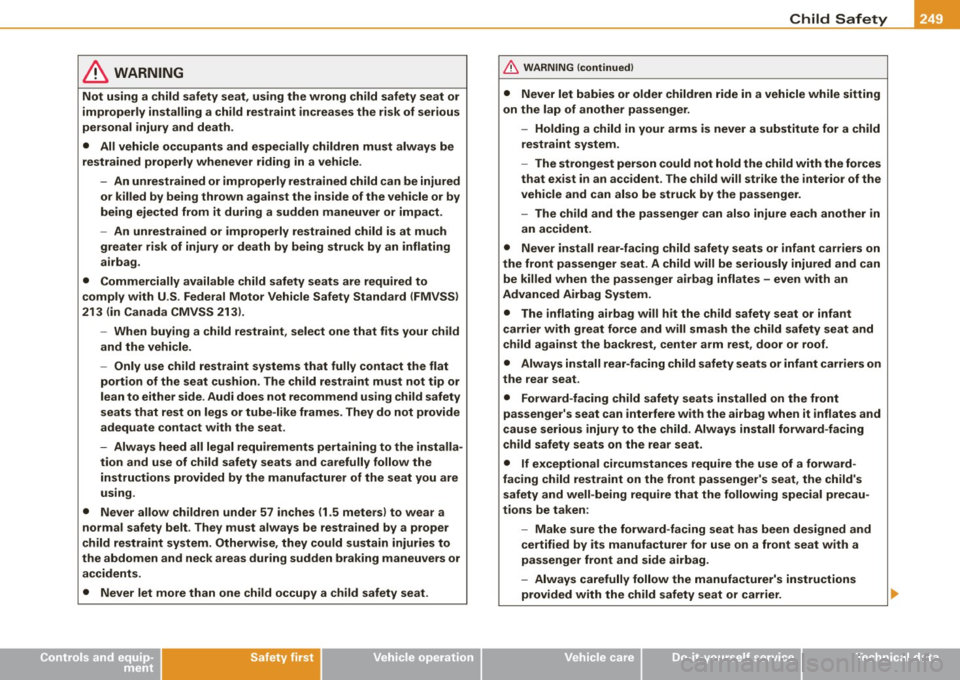
_______________________________________________ C_h _ i_ld _ S_ a_ f_ e_ t..,:c y __ ffllll
& WARNING
Not using a child safety seat, using the wrong child safety seat or
improperly installing a child restraint increases the risk of serious
personal injury and death .
• All vehicle occupants and especially children must always be
restrained properly whenever riding in a vehicle .
- An unrestrained or improperly restrained child can be injured or killed by being thrown against the inside of the vehicle or by
being ejected from it during a sudden maneuver or impact.
- An unrestrained or improperly restrained child is at much
greater risk of injury or death by being struck by an inflating
airbag.
• Commercially available child safety seats are required to
comply with U .S . Federal Motor Vehicle Safety Standard (FMVSS l
213 (in Canada CMVSS 213).
-When buying a child restraint , select one that fits your child
and the vehicle .
- Only use child restraint systems that fully contact the flat
portion of the seat cushion. The child restraint must not tip or
lean to either side . Audi does not recommend using child safety
seats that rest on legs or tube -like frames . They do not provide
adequate contact with the seat .
- Always heed all legal requirements pertaining to the installa
tion and use of child safety seats and carefully follow the
instructions provided by the manufacturer of the seat you are
us ing .
• Never allow children under 57 inches {1 .5 meters) to wear a
normal safety belt . They must always be restrained by a proper
child restraint system . Otherwise , they could sustain injuries to
the abdomen and neck areas dur ing sudden braking maneuvers or
accidents.
• Never let more than one child occupy a child safety seat .
Controls and equip ment Safety first
Vehicle operation
& WARNING (continued )
• Never let babies or older children ride in a vehicle while sitting
on the lap of another passenger .
- Holding a child in your arms is never a substitute for a child
restraint system .
- The strongest person could not hold the child with the forces
that exist in an ac cident. The child will strike the interior of the
vehicle and can also be struck by the passenger .
- The child and the passenger can also injure each another in
an accident.
• Never install rear-facing child safety seats or infant carriers on
the front passenger seat . A child will be seriously injured and can
be killed when the passenger airbag inflates - even with an
Advanced Airbag System .
• The inflating airbag will hit the child safety seat or infant
carrier with great force and will smash the child safety seat and
child against the backrest , center arm rest , door or roof .
• Always install rear-facing child safety seats or infant carriers on
the rear seat .
• Forward -facing child safety seats installed on the front
passenger 's seat can interfere with the airbag when it inflates and
cause serious injury to the child. Always install forward -facing
child safety seats on the rear seat .
• If exceptional circumstances require the use of a forward
facing child restraint on the front passenger's seat , the child's
safety and well-being require that the following special precau
tions be taken :
- Make sure the forward -facing seat has been designed and
c ertified by its manufacturer for use on a front seat with a
passenger front and side airbag.
- Always carefully follow the manufacturer's instructions
provided with the child safety seat or carrier.
Vehicle care Do-it-yourself service Technical data
Page 253 of 408
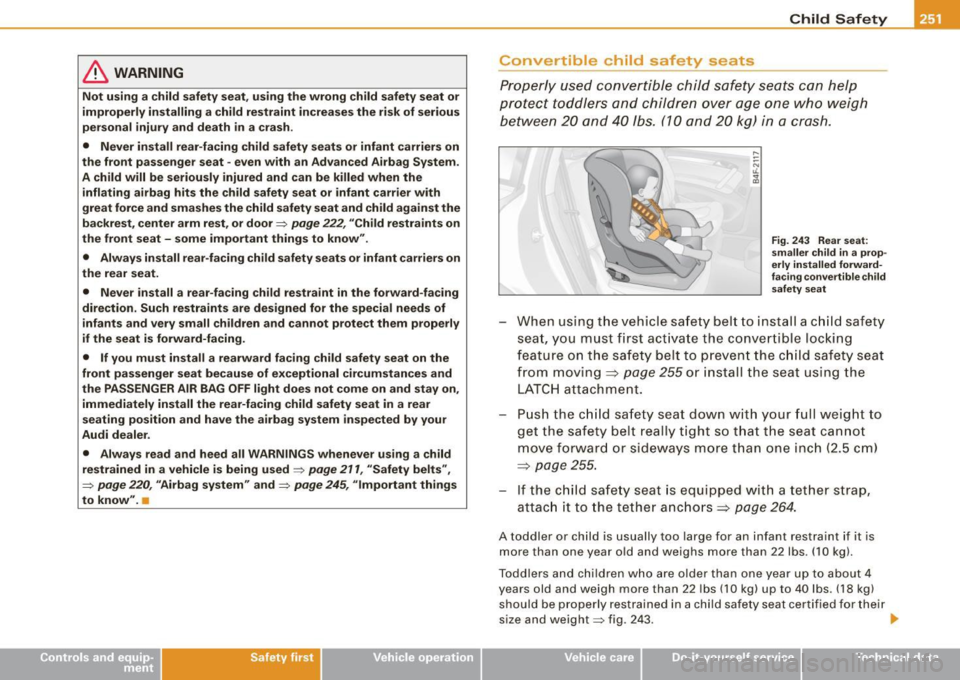
& WARNING
Not using a child safety seat, using the wrong child safety seat or
improperly installing a child restraint increases the risk of serious
personal injury and death in a cr ash .
• Never install rear-facing child safety seats or infant carriers on
the front passenger seat -even with an Advanced Airbag System .
A child will be seriously injured and can be killed when the
inflating airbag hits the child safety seat or infant carrier with
great force and smashes the child safety seat and child against the
backrest , center arm rest, or door=>
page 222, "Child restraints on
the front seat -some important things to know" .
• Always install rear-facing child safety seats or infant carriers on
the rear seat.
• Never install a rear-facing child restraint in the forward-facing
direction. Such restraints are designed for the special needs of
infants and very small children and cannot protect them properly
if the seat is forward-facing.
• If you must install a rearward facing child safety seat on the
front passenger seat because of exceptional circumstances and
the PASSENGER AIR BAG OFF light does not come on and stay on,
immediately install the rear-facing child safety seat in a rear
seating position and have the airbag system inspected by your
Audi dealer .
• Always read and heed all WARNINGS whenever using a child
restrained in a vehicle is being used
=> page 211 , "Safety belts",
=> page 220, "Airbag system" and => page 245, "Important things
to know". •
Safety first
Child Safety
Convertible ch ild safety seats
Properly used convertible child safety seats can help
protect toddlers and children over age one who weigh between 20 and 40 lbs. (10 and 20 kg) in a crash.
Fig . 243 Rear seat:
smaller child in a prop
erly installed forward
facing convertible child safety seat
-When using the vehicle safety belt to install a child safety
seat, you must first activate the convertible locking
feature on the safety belt to prevent the child safety seat
from moving :::;,
page 255 or install the seat using the
LATCH attachment.
- Push the child safety seat down with your full weight to
get the safety belt really tight so that the seat cannot
move forward or sideways more than one inch (2.5 cm)
:::;, page 255.
- If the child safety seat is equipped with a tether strap,
attach it to the tether anchors :::;,
page 264.
A toddler or child is usually too large for an infant restraint if it is
more than one year old and weighs more than 22 lbs. (10 kgl.
Toddlers and children who are older than one year up to about 4
years old and weigh more than 22 lbs (10 kg) up to 40 lbs . (18 kg)
should be properly restrained in a child safety seat certified for their
size and weight=> fig. 243. .,
Vehicle care I I Technical data
Page 257 of 408
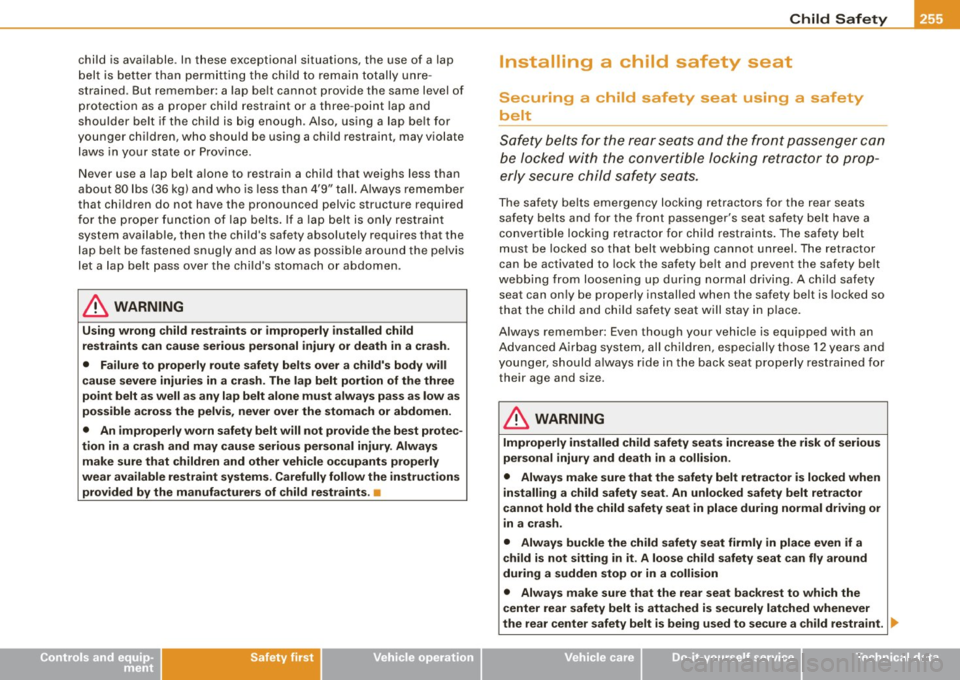
Child Safety -
--------------------''---
child is available. In these exceptional situations, the use of a lap
belt is better than perm it t ing the chi ld to remain totally unre
strained . But remember: a lap be lt cannot provide the same level of
protection as a proper child restraint or a three -point lap and
shoulder belt if the child is big enough . Also, using a lap belt for
younger child ren, who should be using a chi ld restraint, may vio late
laws in your state o r Province .
Never use a lap belt a lone to res train a chi ld tha t weighs less than
about 80 lbs (36 kg) a nd who is less than 4'9" tall. A lways remember
that children do not have the pronounced pelvic structure required
for the pro per func tion of lap belts . If a lap bel t is only restrain t
system available, then the chi ld's safety absolutely requires that the
lap be lt be fas tened snugly a nd as low as possible arou nd the pe lvis
let a lap belt pass over the chi ld's stomach or abdomen .
& WARNING
Using wrong child rest raints or improperly installed child
restr aint s can cau se seriou s personal injury or death in a crash.
• Fa ilu re to properly ro ute safety belts over a child's body will
c au se severe injuries in a cra sh. The lap belt portion of the three
point belt a s well a s an y lap belt alone mu st always pas s as low a s
possible acros s the pelvi s, never over the stomach or abdomen .
• An improperly worn safet y belt will not pro vide the best protec
tion in a cra sh and may cause seriou s personal injury . Always
ma ke sure that children and other vehi cle occupants p rope rly
wear available restraint systems . C arefully follow the instructions
provided by the manufacturers of child re straints . •
Controls and equip ment Safety first
Vehicle operation
Installing a child safety seat
Securing a child safety seat using a safety
belt
Sa fety belts for the r ear seats an d the fr ont passenger con
be locked with the convertible locking retractor to prop
erly secure child safety seats .
The safety belts eme rgency locking retractors for the rear seats
safety belts and for the front passenger's seat safety belt have a
convertible locking ret ractor for child rest raints . The safety belt
must be locked so that belt webbing cannot unreel. T he ret ractor
can be activated to lock the safety be lt and prevent the safety be lt
webbi ng fro m loosen ing up dur ing norma l driving . A child sa fety
seat can on ly be properly installed when the safety belt is locked so
that the child a nd ch ild safety seat will s tay i n place .
A lways remember: Even though your vehic le is equipped with an
Advanced A irbag system, all child ren, espec ially those 12 years and
younger , should a lways ride in the back seat properly restrained for
their age and size.
& WARNING
Improperly installed child safety seat s increase the risk of serious
pe rsonal injury and death i n a collision.
• Always make sure that the safety belt retractor i s locked when
in stalling a child safety seat. An unlocked safety b elt retracto r
cannot hold the child safety seat in pla ce during normal driving or
in a cr ash.
• Always buckle the child safety seat firmly in place even if a
c hild i s not sitting in it . A loo se ch ild safety seat can fly around
durin g a sudden stop or in a collision
• Always make su re that the re ar se at ba ckrest to which the
center rear safety belt is atta ched is se curely latched wh enever
the re ar center safety belt is being u sed to se cur e a child re stra int .
9)1,
Vehicle care Do-it-yourself service Technical data